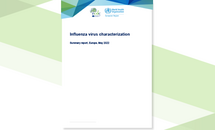Influenza virus characterisation - Summary Europe, June 2020
ECDC’s influenza virus characterisation reports are published periodically and give an overview of circulating influenza viruses. They provide details on the current vaccine strains, summarise the development of the viruses since the last report, and closely follow the main developments for the ongoing influenza season. Virus characterisation reports are primarily intended for influenza virologists and epidemiologists.
Executive Summary
This is the eighth report for the 2019–20 influenza season. As of week 25/2020, 164 883 influenza detections across the WHO European Region had been reported; 73% type A viruses, with A(H1N1)pdm09 prevailing over A(H3N2), and 27% type B viruses, with 4 479 (98%) of 4 568 ascribed to a lineage being B/Victoria.
Since the May 2020 characterisation report1, nine shipments of influenza-positive specimens from EU/EEA countries have been received at the London WHO CC, the Francis Crick Worldwide Influenza Centre (WIC). In total, 1 608 virus specimens, with collection dates after 31 August 2019, have been received.
Of the 99 A(H1N1)pdm09 viruses from EU/EEA countries characterised antigenically since the May report, 77 were well recognised by antisera raised against the 2019–20 vaccine virus, A/Brisbane/02/2018. Of those viruses, 22, that showed poor reactivity generally carried amino acid substitutions (notably N156K) in the HA1 150-loop region. The 397 EU/EEA test viruses with collection dates from week 40/2019 genetically characterised at the WIC have fallen within subclades of clade 6B.1A: 358 6B.1A5A, 29 6B.1A5B, 1 6B.1A6 and 9 6B.1A7.
The majority (52) of the 68 A(H3N2) viruses from EU/EEA countries characterised antigenically in June were clade 3C.3a and were well recognised by antiserum raised against egg-propagated A/Kansas/14/2017, the current vaccine virus. Globally, approximately equal proportions of clade 3C.3a and subgroups 3C.2a1b+T131K and 3C.2a1b+T135K viruses have been detected, but for viruses detected since 1 February 2020, subgroups 3c.2a1b+T135KA/B have prevailed in the USA while those of clade 3C.3a and subgroup 3C.2a1b+T131K have dominated in Europe. In total, 438 viruses from EU/EEA countries have been characterised genetically at the WIC: 245 clade 3C.3a, 126 3C.2a1b+T131K, 48 3C.2a1b+T135K-A and 19 3C.2a1b+T135K-B.
Sixty-nine B/Victoria-lineage viruses from EU/EEA countries were antigenically characterised in June, 63 subclade 1A(Δ3)B, one subclade 1A(Δ2) and five not sequenced. Approximately 25% of the subclade 1A(Δ3)B viruses were not recognised well by antiserum raised against B/Washington/02/2019, the vaccine virus for the 2020–2021 northern hemisphere influenza season. Poor recognition was generally associated with HA1 amino acid substitutions of either N126K or E128K. In total, 269 EU/EEA viruses have been characterised genetically at the WIC: 255 subclade 1A(Δ3)B and 14 subclade 1A(Δ2).
Download







